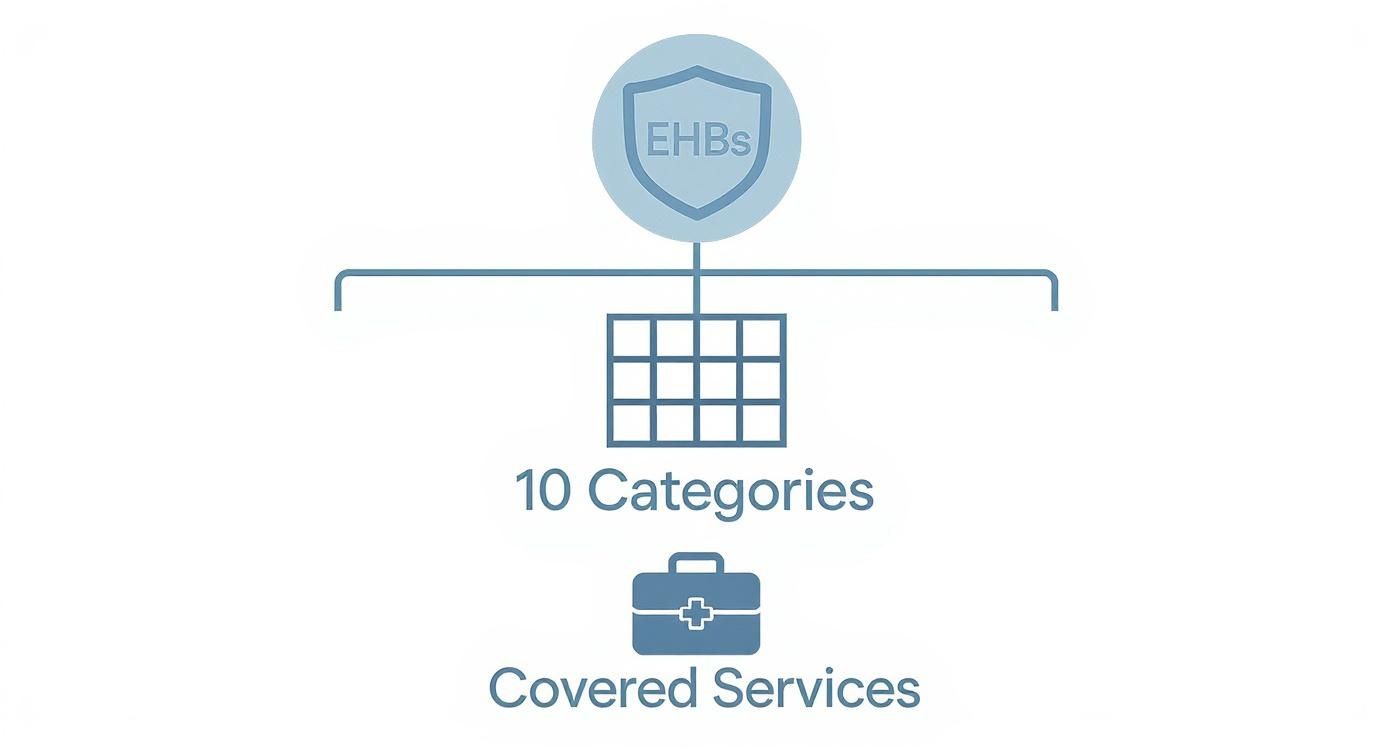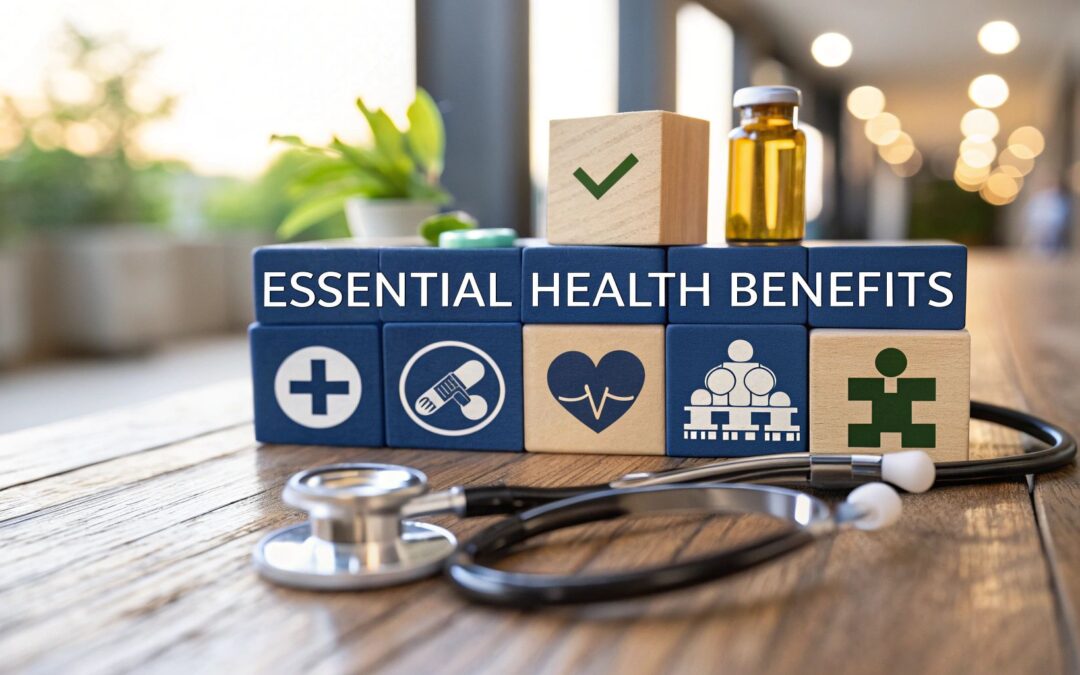When you're shopping for health insurance, it's easy to get lost in the details—premiums, deductibles, networks. But what about what the plan actually covers? That’s where the 10 Essential Health Benefits (EHBs) come in.
Think of them as the non-negotiable, foundational pillars of any solid health plan sold under the Affordable Care Act (ACA). They’re a mandatory checklist of services, ensuring your policy isn’t secretly missing something critical when you need it most, like emergency care or prescription drug coverage.
Decoding the Foundation of Your Health Coverage
Imagine you’re building a house. You wouldn't even consider skipping the foundation, the plumbing, or the electricity, right? They're essential. Essential Health Benefits serve the exact same purpose for your health insurance. They create a sturdy, reliable plan that protects you from discovering dangerous gaps in your coverage after it’s too late.
Before the ACA, an insurance plan could look great on paper but secretly exclude something huge, like maternity care or mental health services. EHBs changed that by setting a consistent, nationwide quality standard for most individual and small-group plans. This means you can finally compare plans knowing they all include the same core categories of care.
Why This Matters for Everyone
This isn't just about red tape; it's about security and predictability. Instead of digging through the fine print to see if a trip to the ER is covered, you can focus on what really makes a plan different—like its network of doctors and its overall costs.
This framework is a huge step forward. For a bit of perspective, as of 2021, the World Health Organization reported that about 4.5 billion people worldwide were not fully covered by essential health services. Mandates like the EHBs are designed to close that gap, starting here at home.
The big idea behind EHBs is refreshingly simple: Health insurance should actually cover your health. It’s a consumer protection that prevents plans from having hidden, dangerous holes, so you know you're getting a reliable and comprehensive product.
Getting a handle on these ten benefits is the first step to becoming a truly empowered healthcare consumer. And if you run into confusing terms along the way, our comprehensive health insurance glossary is always there to help clear things up. When you know what must be included, you can evaluate your options with confidence and choose the plan that truly fits your life.
To make it even clearer, here's a quick rundown of the 10 categories every ACA-compliant plan must cover.
The 10 Essential Health Benefit Categories at a Glance
This table gives you a quick overview of the 10 mandated EHB categories, showing the broad scope of coverage required in ACA-compliant plans.
| Category Number | Benefit Category | What It Covers |
|---|---|---|
| 1 | Ambulatory Patient Services | Outpatient care you get without being admitted to a hospital (also known as outpatient care). Think doctor's office visits and specialty clinics. |
| 2 | Emergency Services | Care you receive for an emergency, like a trip to the emergency room. This is covered even if the hospital is out-of-network. |
| 3 | Hospitalization | Inpatient care, including semi-private rooms, meals, and nursing services, for situations like surgery or overnight observation. |
| 4 | Maternity and Newborn Care | Care before, during, and after your baby is born. This includes prenatal checkups, delivery, and postnatal care. |
| 5 | Mental Health and SUD Services | Inpatient and outpatient care for mental health and substance use disorders, including behavioral health treatment like counseling. |
| 6 | Prescription Drugs | Medications prescribed by a doctor. Plans must cover at least one drug in every U.S. Pharmacopeia category. |
| 7 | Rehabilitative Services | Services and devices to help you recover skills, abilities, and functions lost due to injury, disability, or a chronic condition. |
| 8 | Laboratory Services | Diagnostic tests like blood work and imaging that help your doctor understand and manage your health. |
| 9 | Preventive and Wellness Services | Services that prevent illness or detect it early, such as checkups, screenings (like mammograms), and immunizations. |
| 10 | Pediatric Services | Healthcare for children, including dental and vision care. |
Knowing these categories are built into your plan from the start gives you a solid foundation to stand on as you navigate your healthcare journey.
Breaking Down the 10 Core Benefit Categories
Knowing your plan has to cover "essential health benefits" is one thing. But what does that actually mean for you in the real world? Let's peel back the layers and look at what each of the 10 core categories really covers.
Think of these less like abstract rules and more like shields, each one protecting a different part of your health and your finances. Every category guarantees a specific type of care is available, stopping an insurer from just denying an entire class of treatments. It creates a safety net you can count on.
This diagram shows how these 10 categories form the bedrock of your plan's coverage.

You can see how the EHBs are the big-picture promise, with the 10 categories organizing all the individual services your plan provides underneath.
Care Outside the Hospital Walls
The first couple of categories cover the care you get without an overnight hospital stay. For most of us, this is where we interact with the healthcare system most often.
-
1. Ambulatory Patient Services (Outpatient Care): This is your day-to-day healthcare. It’s your regular doctor's office visits, appointments with specialists like a cardiologist or dermatologist, and even minor surgeries that don’t require you to be admitted. If you aren't staying overnight in a hospital, it probably falls under this benefit.
-
2. Emergency Services: This one is huge. If you have a medical emergency, your plan must cover your care. Critically, this protection applies even if you have to go to an out-of-network hospital because it's an emergency. Insurers can't force you to get pre-approval before you run to the ER.
Inpatient and Family-Focused Care
Next up are benefits for more intensive medical situations, like hospital stays and the journey of growing your family. These are often the high-cost events where having solid coverage is an absolute game-changer.
-
3. Hospitalization: This is for inpatient care—when you are formally admitted to a hospital for a major surgery, a serious illness, or intensive treatment. It helps pay for things like your semi-private room, nursing care, and the medications you get during your stay.
-
4. Maternity and Newborn Care: This benefit ensures coverage for care before, during, and after pregnancy. It includes everything from prenatal checkups and screenings to labor, delivery, and postpartum care for mom and the new baby. We take a much deeper look into this in our guide on how health insurance covers labor and C-sections.
Mental Health and Medication Access
Under the ACA, mental and physical health are finally treated with the same importance. These next categories, along with prescription drug coverage, ensure you have access to the ongoing treatments that are so crucial for your overall well-being.
-
5. Mental Health and Substance Use Disorder Services: This requires plans to cover behavioral health treatments like counseling, psychotherapy, and inpatient services. It also established mental health parity, which means an insurer can't put stricter limits on mental healthcare than it does on physical healthcare. This protection has opened the door to more accessible care, including options for online depression treatment.
-
6. Prescription Drugs: Your plan has to cover prescriptions. To make sure you have broad access, policies are required to cover at least one drug in every U.S. Pharmacopeia category. This prevents scary gaps where an entire type of necessary medication might be left off your plan's approved list (its formulary).
Recovery and Diagnostic Support
These next benefits are all about helping you get back on your feet and giving your doctor the tools they need to figure out what's going on.
-
7. Rehabilitative and Habilitative Services and Devices: This is a crucial category that people often get confused.
- Rehabilitative services help you recover skills you lost because of an injury or illness—think physical therapy after a bad fall.
- Habilitative services help you learn skills you never had, like speech therapy for a child with a developmental delay.
-
8. Laboratory Services: This covers all the tests your doctor uses to diagnose an illness or keep an eye on a condition. We're talking about blood work, X-rays, and other diagnostic tools that are absolutely essential for good medical care.
Preventive and Pediatric Care
Finally, the EHBs put a strong emphasis on proactive health and specialized care for kids, building a foundation for a long, healthy life.
-
9. Preventive and Wellness Services and Chronic Disease Management: This category is designed to stop illnesses before they start. It covers things like annual checkups, flu shots, and important cancer screenings like mammograms. The best part? Many of these services must be covered at no cost to you, without even a copay.
-
10. Pediatric Services, Including Oral and Vision Care: All ACA-compliant plans have to include benefits for children. This means routine checkups and immunizations are covered. Just as importantly, it mandates that plans offer dental and vision coverage for kids under 19.
How These Benefits Protect You and Your Family

It’s one thing to see a list of "essential health benefits," but it’s another thing entirely to understand how they work as a real-world safety net for you and your loved ones. Think of it like this: your health insurance isn’t just a card in your wallet. It’s comprehensive protection, the same way full-coverage insurance protects your car from fender benders and major accidents alike.
This framework is so much more than a checklist. It's a genuine shield against financial ruin, making sure a sudden illness or a new baby doesn't leave you with a mountain of debt. Each of the ten benefit categories covers a different part of your life, all working together to guard your health and your finances.
Protection Through Every Stage of Life
The real value of these benefits snaps into focus when you see how they apply to your life right now. The health needs of a young professional are worlds apart from those of a growing family, but the EHB framework was built to protect everyone, no matter where they are on their journey.
If you’re a young adult building a career, the guaranteed inclusion of mental health and substance use disorder services is a game-changer. It means you have access to therapy and counseling to manage stress and stay well—no questions asked. This puts mental healthcare on the same level as seeing a doctor for a physical issue, right where it belongs.
This proactive mindset is becoming more common everywhere. In big markets like the United States, about half of all consumers are now buying products for their nutritional benefits, treating food as a form of preventive medicine. You can dive deeper into these trends in this insightful report on the future of wellness.
Security for a Growing Family
For anyone starting or expanding their family, the essential benefits offer a profound kind of peace of mind. The protections are specific, powerful, and designed for life’s biggest moments.
The EHB mandate ensures that no matter which ACA-compliant plan you choose, you won't be left vulnerable during critical life events. It standardizes the promise of coverage, allowing you to focus on your family's health, not the fine print.
This security is built on a few core pillars of the EHB structure:
- Maternity and Newborn Care: This is huge. It guarantees coverage for prenatal visits, labor and delivery, and postpartum care. Before the ACA, many plans on the individual market flat-out excluded maternity coverage, leaving new parents with tens of thousands of dollars in bills.
- Pediatric Services: Your kids’ health comes first, with coverage for everything from well-child visits and shots to crucial dental and vision care. It helps build a strong foundation for a healthy life, right from the start.
- Preventive Care: Access to free preventive services, like screenings and annual checkups, helps your whole family stay healthy. It’s all about catching small issues early before they become bigger, more expensive problems down the road.
Connecting EHBs to Your Insurance Plan Details
https://www.youtube.com/embed/wCyEQLyKbUY
Knowing the ten essential health benefit categories exist is the first step. But how do you actually see them in the health plan you’re about to buy? It's a great question.
While every single ACA-compliant plan must cover these benefits, the specific services and limits can look surprisingly different from one policy to another. This is because the federal government sets the broad categories, but each state gets to fine-tune the details.
Think of it like a national building code. Every new house has to have plumbing, electricity, and a solid foundation—those are the EHBs. However, one state might require copper pipes while another allows PVC. That’s where the specific plan details come in.
States do this by choosing a benchmark plan, which is just an existing health insurance policy that serves as the model for all other individual and small-group plans sold in that state. This creates a consistent standard, so you know every plan is built on the same core blueprint.
How Benchmark Plans Define Your Coverage
The benchmark plan is what sets the nitty-gritty details for what’s covered within each of the ten EHB categories.
For example, one state's benchmark might require coverage for 30 physical therapy visits per year, while another's only requires 20. This kind of detail is exactly what you need to look for when comparing your options.
It also means that when you’re looking at individual and family health plans, you should always check the "Summary of Benefits and Coverage" document. This is a standardized form that makes it super easy to see what’s included and how much you'll pay. For families, understanding these specifics—like how to find a pediatric eye doctor accepting Medicaid—is especially important.
The Powerful Financial Protections of EHBs
Beyond just defining what’s covered, the EHB framework gives you two of the most powerful financial shields in modern health insurance. These are the rules that truly protect you and your family from catastrophic medical debt.
The biggest financial rule tied to EHBs is the ban on annual and lifetime dollar limits. An insurer cannot cap the total amount it will spend on your essential care—not over a year, and not over your entire life. This ensures your coverage won't just disappear when you need it most.
This single rule prevents the horror stories from before the ACA, where someone with a serious illness would hit their lifetime maximum and suddenly be left uninsured. It’s a core promise of your coverage.
On top of that, essential health benefits are directly tied to your plan’s out-of-pocket maximum. This is the absolute most you will have to pay for covered services in a plan year. Once you hit this limit, your insurance company pays 100% for all covered EHBs for the rest of the year.
This gives you a predictable financial ceiling on your healthcare costs, which is one of the most vital protections EHBs offer.
How to Review a Plan for EHB Coverage

Just knowing a plan includes essential health benefits is your starting point, not the finish line. Since the specifics can vary from one plan to another, you need to dig into the details to find the best fit for your life and your health.
Your most powerful tool for this is the Summary of Benefits and Coverage (SBC). Every ACA-compliant plan is required to provide this easy-to-read, standardized document. It’s designed to cut through the jargon and clearly lay out what the plan covers and what you’ll actually pay for different services.
Asking the Right Questions
When you get that SBC, don’t just give it a quick scan. You need to look for answers to questions that matter to you. This is where you connect the dots between the plan’s rules and your real-world needs.
Your checklist should include questions like:
- Prescription Drugs: Are the medications I take on the plan’s approved list (its formulary)? If so, what tier are they on, and what will my copay be?
- Mental Health: What will I pay in copays or coinsurance for therapy sessions? Are there any limits on how many visits I can have per year?
- Specialist Care: Will I need a referral from my primary doctor to see a specialist? What’s my out-of-pocket cost for each visit?
Getting comfortable with this process is what separates savvy consumers from the rest. It's the difference between picking a plan that simply "covers" EHBs and choosing one that provides affordable, accessible care for the services you know you’ll use.
A Real-World Comparison
Let’s say you’re managing a chronic condition like arthritis. You depend on regular physical therapy (a rehabilitative service) and take a specific brand-name prescription. When comparing two plans, you can't stop at just seeing they both cover these categories.
You have to look deeper. Plan A might offer 30 physical therapy visits a year with a $40 copay, while Plan B only covers 20 visits with a $60 copay. At the same time, Plan A might cover your medication with a much lower copay.
For you, Plan A is the obvious winner, even if its monthly premium is a little higher. It’s built for your needs. For a more detailed walkthrough, check out our complete guide on how to compare health insurance plans. By focusing on these details, you choose a plan that truly works for you.
Still Have Questions About Essential Health Benefits? Let's Clear Them Up
As you get a feel for what essential health benefits are all about, it’s completely normal for a few "what if" questions to surface. Getting the details right isn't about memorizing rules—it’s about understanding your rights and feeling confident in the coverage you choose.
Let's tackle some of the most common questions head-on to clear up any confusion.
Do All Health Insurance Plans Really Cover the 10 EHBs?
Not quite. It’s a common misconception that every single plan on the market has to follow these rules.
The requirement to cover the 10 EHBs mainly applies to individual and small group plans. These are the types of plans you'd typically buy for yourself or your family, often through the Health Insurance Marketplace.
However, there are a few exceptions. These plans are often not required to include all ten EHBs:
- Short-term health insurance plans, which are only meant to fill temporary gaps in coverage.
- Large employer-sponsored plans, though most large companies choose to offer comprehensive benefits anyway.
- "Grandfathered" plans—policies that existed before the ACA became law back in March 2010.
This is why you can't just assume. Always, always check the specific documents for your plan to see exactly what's covered.
If Something Is an EHB, Does That Mean My Care Is Free?
No, and this is probably the biggest point of confusion out there. "Covered" definitely doesn't mean "free."
While your plan is required to offer services in each of the ten EHB categories, you're still responsible for your share of the costs. Think of it this way: the plan is there to help you pay, not to pay for everything entirely.
With the exception of certain preventive services that are provided at no cost to you, most EHBs are subject to your plan’s cost-sharing. That means you’ll still have to pay your:
- Deductible: The amount you pay for your care before your insurance plan starts chipping in.
- Copayments: A flat fee you pay for a specific service, like a doctor's visit.
- Coinsurance: The percentage of the bill you're responsible for after you've met your deductible.
The EHB rules guarantee that your plan will be there to share the financial load for these essential services, but it doesn't erase your part of the bill.
But here’s the most powerful protection that comes with EHBs: the ban on annual or lifetime dollar limits. This is huge. It means an insurance company can never say, "Sorry, you've hit your limit," and stop paying for your essential care. This rule is a cornerstone of the ACA, designed to protect you from catastrophic medical debt if you face a serious illness.
Navigating the world of health insurance can feel like a maze, but you don't have to find your way through it alone. The experts at My Policy Quote are here to help you find an ACA-compliant plan that provides the essential health benefits you and your family deserve.
Explore your options and get a free, no-obligation quote today at mypolicyquote.com.


